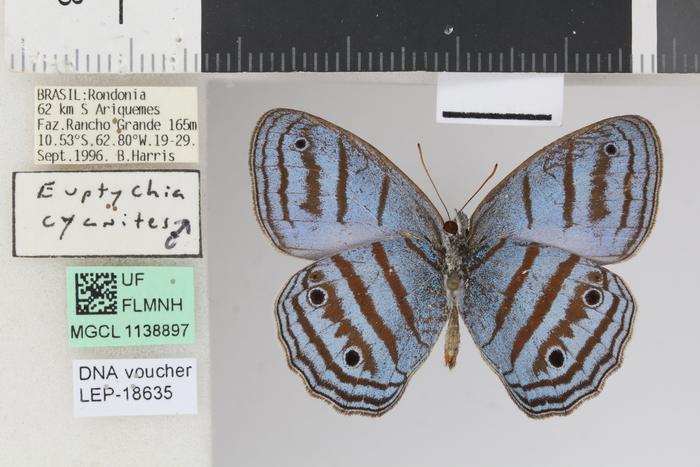When introducing a new species to science, taxonomists always get to choose its scientific name. And while there are some general rules to naming, there’s also relative freedom. Often, new species are named after the area where they were found, or their key diagnostic features, but researchers may also choose names that recognize those who helped or inspired them in their career: prominent scientists, celebrities, and, sometimes, their grandma, or their dog. In Amazonia, a new species of butterfly was discovered whose name honors the decades-long work of someone who has worked patiently behind the scenes in museum collections to provide invaluable support to researchers.

Credit: Nakahara et al.
When introducing a new species to science, taxonomists always get to choose its scientific name. And while there are some general rules to naming, there’s also relative freedom. Often, new species are named after the area where they were found, or their key diagnostic features, but researchers may also choose names that recognize those who helped or inspired them in their career: prominent scientists, celebrities, and, sometimes, their grandma, or their dog. In Amazonia, a new species of butterfly was discovered whose name honors the decades-long work of someone who has worked patiently behind the scenes in museum collections to provide invaluable support to researchers.
Caeruleuptychia harrisi was named in recognition of Brian P. Harris, museum specialist at the Smithsonian National Museum of Natural History, “for his tireless effort in facilitating butterfly research at USNM by going above and beyond to support visiting researchers,” according to a study which was just published in the journal ZooKeys. “Brian has provided critical support to visiting researchers for many years, including several co-authors on the paper,” writes the team of researchers, led by Harvard University’s Shinichi Nakahara.
In fact, Harris personally collected the type specimen that later facilitated the scientific description of the new species. After collecting it in Brazil, he deposited it at USNM, where it could be studied as a reference for this species.
“I think it is really important to recognize someone who has dedicated а good amount of his lifetime providing technical help to support research,” says Shinichi Nakahara.
Brian Harris started working at the Smithsonian Institution in July 2005. There, he served as a museum specialist for Lepidoptera (moths and butterflies) and Hymenoptera (ants, bees, and wasps) until he retired in July 2019.
“Brian’s job curating Lepidoptera and Hymenoptera collections is critical for us visiting researchers to conduct research based on these specimens, but sadly this kind of technical support is often not well recognized well in the current scientific community,” says Shinichi Nakahara. “I visited the Smithsonian’s Lepidoptera collection three times, in 2015, 2018, and 2023 (after his retirement!), and Brian provided me with the best support I could ever receive in all of these three visits. It was evident to me that he wanted us visitors to make the most out of the collections and he went out of his way to support my short visits to the collection.”
“He always communicated with me in advance about which butterfly group I wanted to examine, would set up an imaging system in advance, and even tried to help me find field notes left by a deceased collector by taking me to the stock room and spending time exploring the museum with me!,“ he adds.
Before working at the Smithsonian Institution, Brian Harris spent 18 years at the Natural History Museum of Los Angeles County (LACM). In the mid-1970s and early 1980s, he played drums for a band before starting at LACM.
Original source:
Nakahara S, Kleckner K, Barbosa EP, Lourenço GM, Casagrande MM, Willmott KR, Freitas AVL (2023) Reassessment of the type locality of Euptychia stigmatica Godman, 1905, with the description of two new sibling species from Amazonia (Lepidoptera, Nymphalidae, Satyrinae, Satyrini). ZooKeys 1167: 57-88. https://doi.org/10.3897/zookeys.1167.102979
Journal
ZooKeys
DOI
10.3897/zookeys.1167.102979
Article Title
Reassessment of the type locality of Euptychia stigmatica Godman, 1905, with the description of two new sibling species from Amazonia (Lepidoptera, Nymphalidae, Satyrinae, Satyrini)
Article Publication Date
14-Jun-2023




